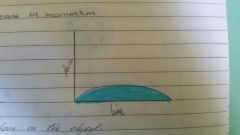![]()
![]()
![]()
Use LEFT and RIGHT arrow keys to navigate between flashcards;
Use UP and DOWN arrow keys to flip the card;
H to show hint;
A reads text to speech;
29 Cards in this Set
- Front
- Back
- 3rd side (hint)
|
Fluid Mechanics |
How an object flow through fluid and the movement created in the fluid |
|
|
|
Laminar flow |
Smooth flow High pressure Low velocity Increases drag |
|
|
|
Turbulent flow |
Decreases drag Multidimensional Changes in momentum Varied pressure and velocity |
|
|
|
Boundary layer |
Is the fluid created a layer by 'sticking' to the outside of the object When the object has a high velocity the boundary layer sticks closer to the back of the object When the object has a lower velocity the boundary covers the object more evenly and separation develops further forward |
|
|
|
Drag |
As a moving object moves the fluid out the way of it's path the the fluid pushes back on the object creating resistance. This resistance is called drag. |
|
|
|
Surface drag |
the part of the drag on a body moving through a fluid that is dependent on the nature of the surface of the body. Dependent of fluid viscosity and surface of object |
|
|
|
Wave drag |
When a body more through a fluid it produces pressure waves Interaction between water and air |
|
|
|
Pressure drag |
Breaking away or separating of a flow of water High pressure is developed in the leading surface and low is developed in trailing surface
Slipstreaming is when an runs, swims, cycles in the turbulent fluid created by the athlete in front of the to decrease the affects of the form drag
|
|
|
|
Bernoullis principle |
Is as the speed increase in moving fluid the pressure decreases |
|
|
|
Impulse |

= size of force×amount of time More time means less force on the object More time more accuracy |
|
|
|
Conservation of momentum |
The total momentum of all the bodies before the collision is equally to the total momentum of all the bodies just after the collision |
|
|
|
Factors the effect elasticity |
Material rubber compared to stone Pressure flat ball compare to and inflated one Surface rebounded from sand compared to pavement Velocity higher velocity lower elasticity Temperature warm object have higher elasticity |
|
|
|
Strength of drag is determined by |
Velocity of movement more velocity more drag Frontal cross section Size and shape of object streamline to have more laminar flow over turbulent flow Viscosity of fiuld |
|
|
|
Momentum |
The amount of motion an object has |
|
|
|
Coefficient of restitution |
Is the measure of elasticity Elasticity is how quickly an object can return to its original shape. (Bounce hight/drop hieght)^0.5 |
|
|
|
Angular momentum |
The angular motion of an object is caused by a eccentric force not a concentric force =angular velocity x angular momentum |
|
|
|
Moment of inertia |
Is the resistance to rotational motion =mass × the distance alway from the axis. |
|
|
|
1st class |
Force axis resistance ⬇ ⬆ ______________________________________ ⚠ Speed and force |
|
|
|
3rd class lever |
Axis force resistance Used for creating speed |
|
|
|
2nd class lever |
Axis resistance force Used for producing Force |
|
|
|
Torque |
Is the eccentric force that causes objects to more Torque = force × perpendicular distance of lever arm Longer arm greater torque less force needed for the same amount of acceleration and object gainsb |
|
|
|
Balance |
The ability to maintain the body's equilibrium COG Stability -resistance to movement -bass support -mass
|
|
|
|
Coordination continuum |
Sequencing and timing body movements to produce speed High force is simultaneous High speed is sequential |
|
|
|
Levers |
Are a ridged bar that turns around and axis |
|
|
|
Force motion |
Law of inertia Law of acceleration Law of action reaction
|
Soccer Rugby Sprinter |
|
|
Optimal projection |
Distance Flat flight 45° angle parabolic High flight Hight of release Velocity of release |
|
|
|
Range of motion |
Total range of motion at key joints Increasing = more force and velocity Decreasing=accuracy |
|
|
|
Segmental interaction |
Body part move in sequence to produce a force Energy transfered muscle to joints Large strong muscles to small fast muscle |
|
|
|
Sequential interaction |
The transferral of energy across body segments and joints to achieve maximal force Segments must be coordinated Each segment sequentially stabilised Maximise the number of segments large to small body segments power/velocity vs precision/accuracy |
|

